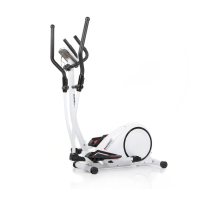Note:
Les pouls varient selon les personnes, la zone de travail
du pouls optimum (zone
cardiovasculaire et aérobique)
peut différer de celle du grand publique.
Dans ces cas, l’entrainement doit être configuré selon les
individus. Si les débutants sont confrontés à ce
phénomène il est important que le médecin soit consulté
avant de commencer l’entrainement, afin de vérifier la
capacité de la santé pour l’exercice.
7.4 Maitrise de l’entrainement
En termes de physiologie et aussi médicalement,
l’entrainement orienté sur la maitrise du pouls est la
meilleure solution.
Cette règle s’applique aux débutants, aux sportifs et aux
professionnels. Cela dépend du but de votre entrainement
et aussi de votre performance, l’entrainement se fait à
une intensité spécifique de votre pouls maximum (exprimé
en pourcentage).
Pour configurer efficacement votre entrainement
cardiovasculaire, nous vous recommandons un
entrainement à 70% - 85% de votre pouls maximum.
Veuillez vous référer à la figure ci-dessous.
Prenez votre pouls dans les temps suivants :
1. Avant l’entrainement = pouls en repos
2. 10 minutes après avoir commencé l’entrainement = pouls
pendant l’entrainement
3. Une minute après avoir fini l’entrainement = pouls en
rétablissement
Pendant les premières semaines il est recommandé que
l’entrainement se fasse avec un pouls assez bas dans la
zone de travail cardiovasculaire (environ 70%).
Pendant les 3, 4 mois qui suivent, intensifiez vos
entrainements petit à petit pour atteindre la limite
supérieur de la zone de travail cardiovasculaire (environ
85%) sans vous épuiser.
Si vous avez une bonne condition physique, la
consommation métabolique sera supérieure
qu’auparavant au même niveau d’entrainement. En
phase de récupération, le travail sera alors plus efficace.
Donc la récupération se fera dans de meilleures
conditions. Un entrainement excessif diminuera votre
résultat
Chaque entrainement doit être suivi par une
périoded’entrainement régénératrice dans laquelle vous
allez rester dans la limite inférieure de la zone de travail
cardiovasculaire (jusqu’à 75% du pouls maximum).
Note:
Because there are persons who have „high“ and „low“
pulses, the individual optimum pulse zones (aerobic
zone, anaerobic zone) may differ from those of the
general public (target pulse diagram).
In these cases, training must be configured according to
indivi-dual experience. If beginners are confronted with
this phenome-non, it is important that a physician be
consulted before starting training, in order to check
health capacity for training.
7.4 Training control
Both medically and in terms of training physiology,
pulse-cont-rolled training makes most sense and is
oriented on the indivi-dual maximum pulse.
This rule applies both to beginners, ambitious
recreational ath-letes and to pros. Depending on the goal
of training and perfor-mance status, training is done at a
specific intensity of individual maximum pulse (expressed
in percentage points).
In order to effectively configure cardio-circulatory training
accor-ding to sports-medical aspects, we recommend a
training pulse rate of 70 % - 85 % of maximum pulse.
Please refer to the following target pulse diagram.
Measure your pulse rate at the following points in time:
1. Before training = resting pulse
2. 10 minutes after starting training = training / working pulse
3. One minute after training = recovery pulse
During the first weeks, it is recommended that training
be done at a pulse rate at the lower limit of the training
pulse zone (approximately 70 %) or lower.
During the next 3 - 4 months, intensify training stepwise
until you reach the upper end of the training pulse zone
(approximately 85 %), but without overexerting yourself.
If you are in good training condition, disperse easier units
in the lower aerobic range here and there in the training
program. so that you regenerate sufficient- ly. „Good“
training always means training intelligently, which
includes regeneration at the right time. Otherwise
overtraining results and your form degenerates.
Every loading training unit in the upper pulse range of
individual performance should always be followed in
subsequent training by a regenerative training unit in the
lower pulse range (up to 75 % of the maximum pulse).
23

